| Author |
Message |
|
E.B. Erickson
Industry Professional
|
 Posted: Fri 22 Sep, 2017 4:15 am Post subject: Posted: Fri 22 Sep, 2017 4:15 am Post subject: |
 |
|
English, probably last half of the 1700s.
38" se blade with wide and narrow fullers that begin about 6" below the hilt.
Basket is built upon a heart shaped base, with two scrolled side branches on the left and three on the right.
This sword was an eBay purchase of about 5 years ago. It is very rusted, but except for down near the point, is not deeply pitted. The hilt has a golden tone because someone has painted it with gold paint in the past. The grip is a two-piece replacement that I made, as this sword had no grip when purchased. The reason that I made a two piece sandwich grip is that this sword has never been disassembled, and why take something apart when you don't need to? The hilt and blade are tight, and it retains parts of the original leather washer between the hilt and blade shoulder. In the future I will remove the red crusty blade rust, give it a thorough cleaning and see what we've got under all the rust and paint.
Mazansky shows hilts like this, and the Tower has this hilt type, but with a longer grip and curved blades.
 Attachment: 91.93 KB Attachment: 91.93 KB
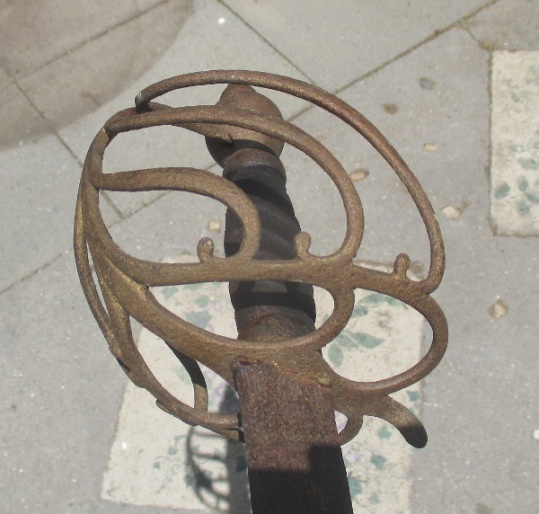
 Attachment: 92.09 KB Attachment: 92.09 KB
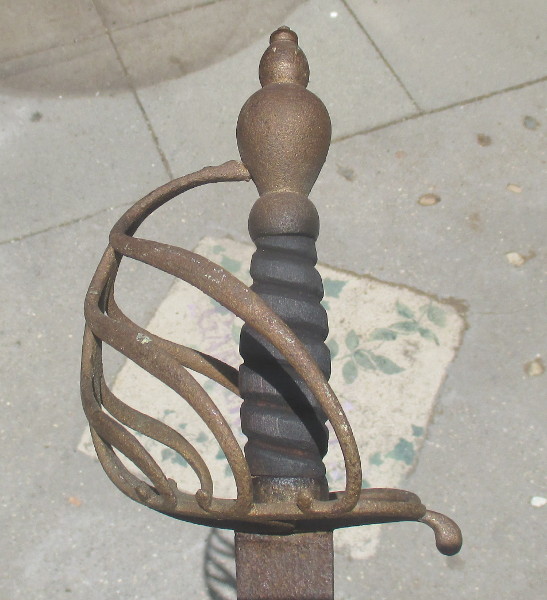
|
|
   |
 |
|
E.B. Erickson
Industry Professional
|
 Posted: Fri 22 Sep, 2017 4:19 am Post subject: Posted: Fri 22 Sep, 2017 4:19 am Post subject: |
 |
|
Germanic half basket, probably early 1600s.
Blade is de, 31 1/4" long, fairly worn, with a short central fuller with 1414 and a running wolf mark.
Hilt is composed of elements hammered together to form a trellis. Usually these hilts are full baskets, but I have seen a photo of a similar half basket in a Norwegian museum. The grip is one of my restorations.
 Attachment: 53.34 KB Attachment: 53.34 KB
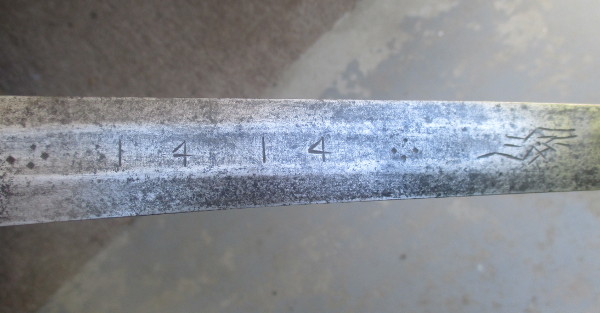
 Attachment: 92.03 KB Attachment: 92.03 KB
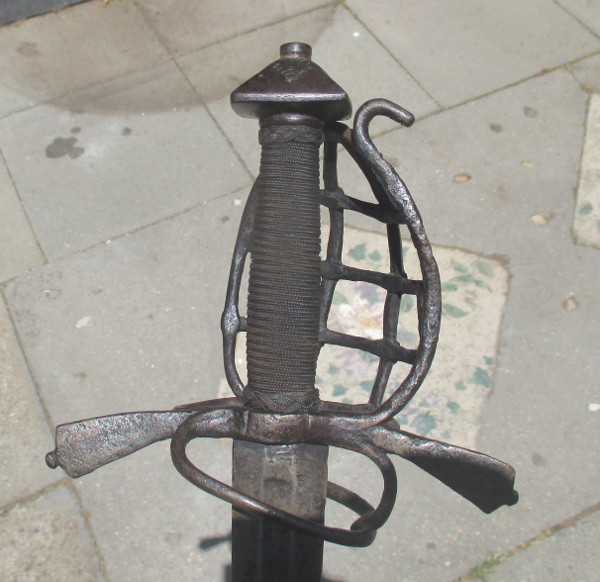
 Attachment: 92.21 KB Attachment: 92.21 KB
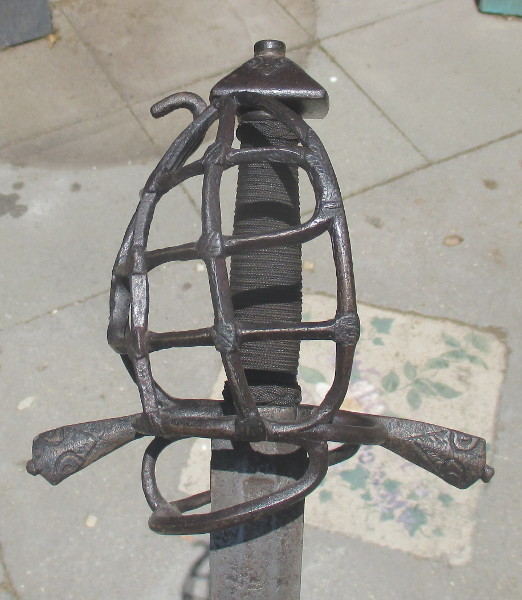
|
|
   |
 |
|
E.B. Erickson
Industry Professional
|
 Posted: Fri 22 Sep, 2017 4:22 am Post subject: Posted: Fri 22 Sep, 2017 4:22 am Post subject: |
 |
|
English Mortuary sword, mid 1600s.
35" se blade with a shallow uneven fuller near the spine. There is a line engraved between the fuller and the spine. The right side is stamped "Ferara" with eyelash marks. The left is stamped "Andrea" with eyelash marks, an additional small stamp near the hilt, and the remnants of a brass inlaid running wolf.
The hilt is rather normal, being engraved with scrolls, punch marks, two grotesque masks and two raised faces. The scrolls and punch mark motif is repeated on the pommel. The grip is original, and is of copper (? the wire might be bronze, but it doesn't look like brass) wire over a wooden core. The whole sword is a bit overcleaned.
The blade is interesting, because I have two other English swords of the early-mid 1600s with similar blades. One is a rapier hilted backsword with a 34" blade, and one a "Hounslow" style hanger (the blade has been shortened to 26" on this sword). Southwick's "Price Guide to Antique Edged Weapons", plate 351 shows another Mortuary sword with this blade type as well. All the blades have a shallow back fuller, all have an engraved line between fuller and spine, all have the same small stamp at the forte, all have "Andrea Ferara" and eyelash stamps. Since all of these blades are in English hilts of the mid 1600s I have to conclude that a large blade order from the same shop/smith (German?) was imported into England around the middle of the century. Has anyone else seen this blade type? And if so, what sort of hilt has been mounted?
 Attachment: 91.79 KB Attachment: 91.79 KB
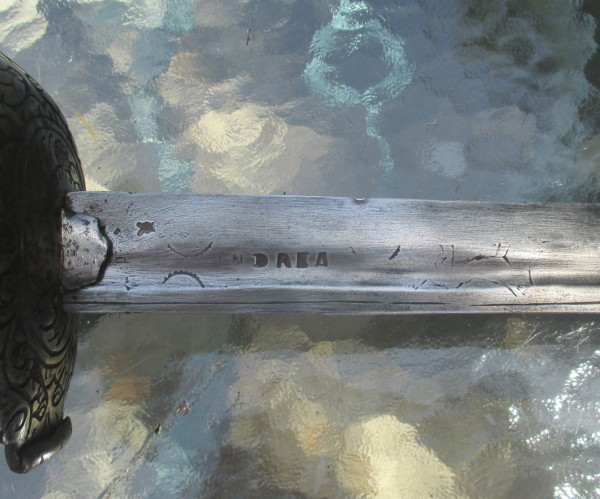
 Attachment: 92.75 KB Attachment: 92.75 KB
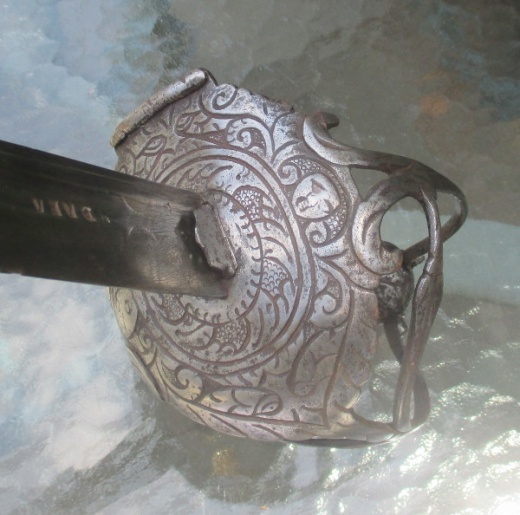
 Attachment: 66.91 KB Attachment: 66.91 KB
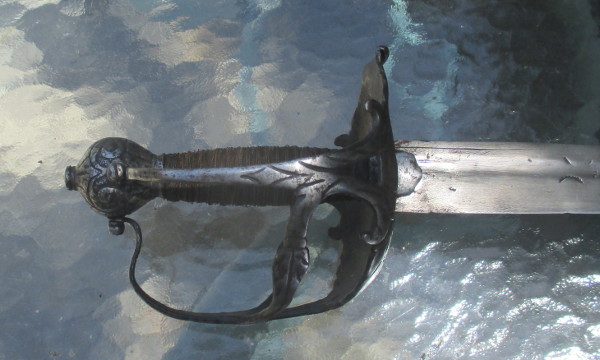
|
|
   |
 |
|
E.B. Erickson
Industry Professional
|
 Posted: Fri 22 Sep, 2017 4:26 am Post subject: Posted: Fri 22 Sep, 2017 4:26 am Post subject: |
 |
|
English "Proto Mortuary" sword, mid 1600s.
Blade is de, 35" long, with a short central fuller within which is 1414 and a running wolf: exactly like the blade on the German half basket above.
Hilt is composed of three shells, the left one is plain and unfluted. The pommel is hollow and rather crude (as is the hilt overall). The grip is another of my restorations.
Mazansky shows a very similar hilt in his tome on p.276.
 Attachment: 82.56 KB Attachment: 82.56 KB
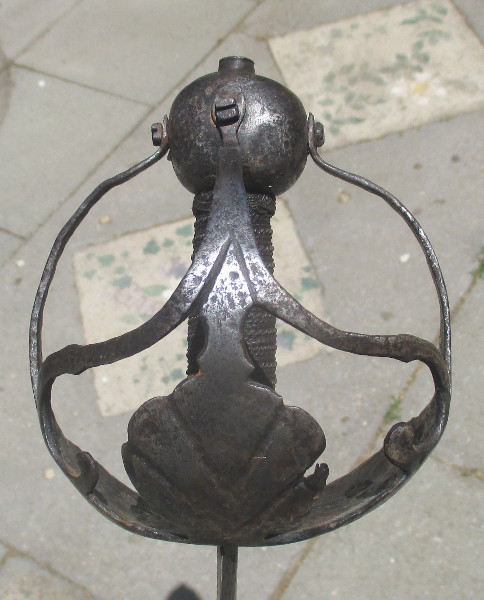
 Attachment: 75.07 KB Attachment: 75.07 KB
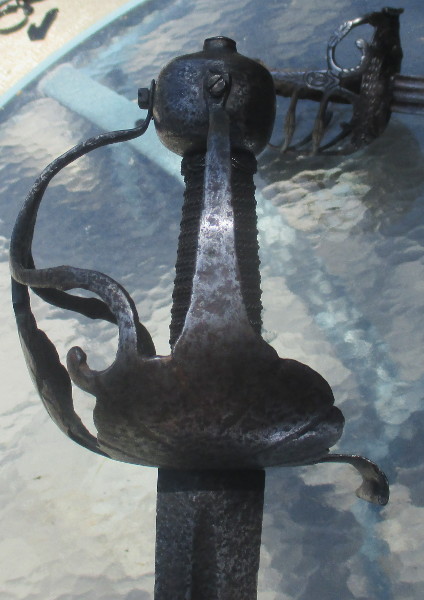
|
|
   |
 |
|
E.B. Erickson
Industry Professional
|
 Posted: Fri 22 Sep, 2017 4:30 am Post subject: Posted: Fri 22 Sep, 2017 4:30 am Post subject: |
 |
|
Another Mortuary sword, mid 1600s.
31 3/4" se blade with two fullers. The fullers are marked "XX ANDRIS X KINDT XX", and "XX IHN X SOLINGEN XX".
The hilt has a more complete basket than the other two Morts I have posted. This hilt is also of much better quality; the chiseling is deep (although a bit crude) and the engraved elements are raised above the surface. The side knucklebows end in animal-headed scrolls, the 4 heads on the guard are in very high relief, and there is an angel at the base of the knucklebow. The background design of the guard is of vegetal elements and scrolls, and this motif is repeated on the pommel. The langets have been reduced on this sword. The grip is original, having brass wire (about 75% still there; the upper Turk's head is gone) over a spiraled wooden core.
 Attachment: 75.65 KB Attachment: 75.65 KB
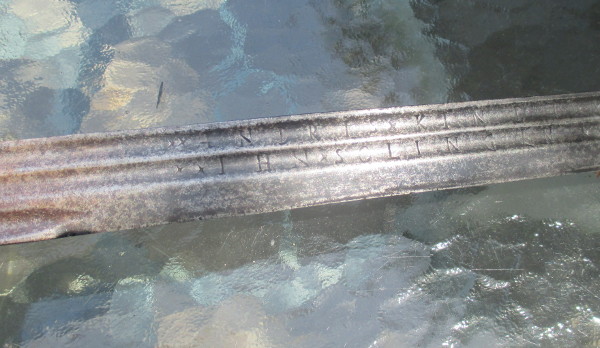
 Attachment: 93.1 KB Attachment: 93.1 KB
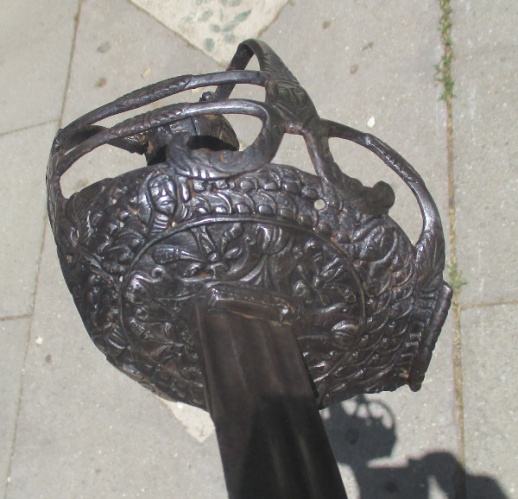
 Attachment: 81.48 KB Attachment: 81.48 KB
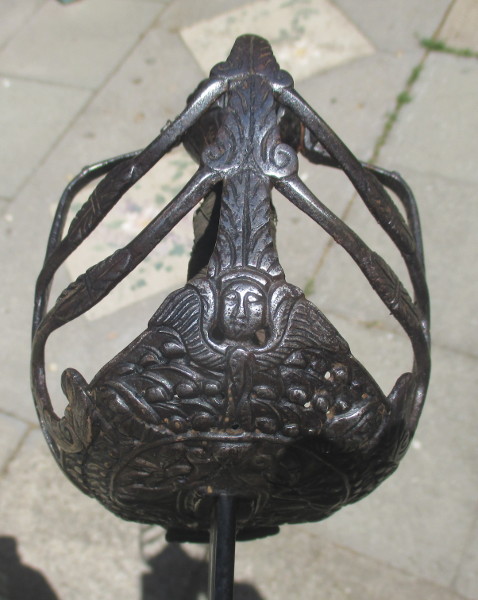
 Attachment: 82.68 KB Attachment: 82.68 KB
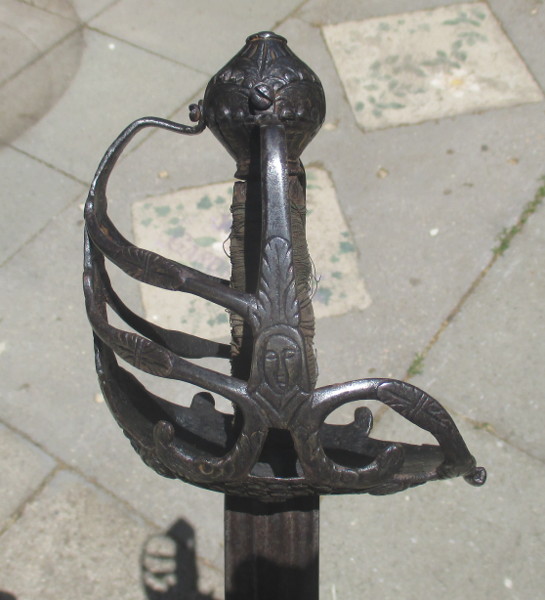
|
|
   |
 |
|
E.B. Erickson
Industry Professional
|
 Posted: Fri 22 Sep, 2017 4:52 am Post subject: Posted: Fri 22 Sep, 2017 4:52 am Post subject: |
 |
|
English cavalry sword, ca. 1750 (?)
This is a big sword. The overall photo makes it look like an infantry officer's sword, but the blade is 34" long by about 1 1/4" wide. The hilt, measured from grip base to capstan, is about 7 1/2" long. The original grip (damaged at base) is covered with sharkskin and bound with a single heavy brass wire. The knucklebow is engraved E/3.
A similar sword is shown in Warren Moore's long out of print "Weapons of the American Revolution and Accoutrements", but the blade on the sword had been shortened to 32" and given a very odd stepped point.
I saw what I think was an officer's version of this sword type at a California auction about 15 years ago. The hilt was identical in size, with a sharkskin grip, but was of steel instead of brass. The hilt was of much better quality than my sword. The blade was identical, with the wide and narrow fuller, but unfortunately had been shortened to about 25".
 Attachment: 33.71 KB Attachment: 33.71 KB
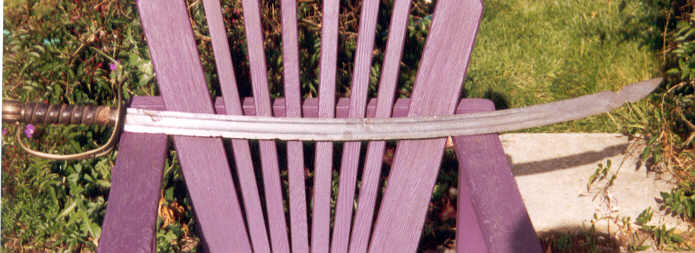
 Attachment: 61.01 KB Attachment: 61.01 KB
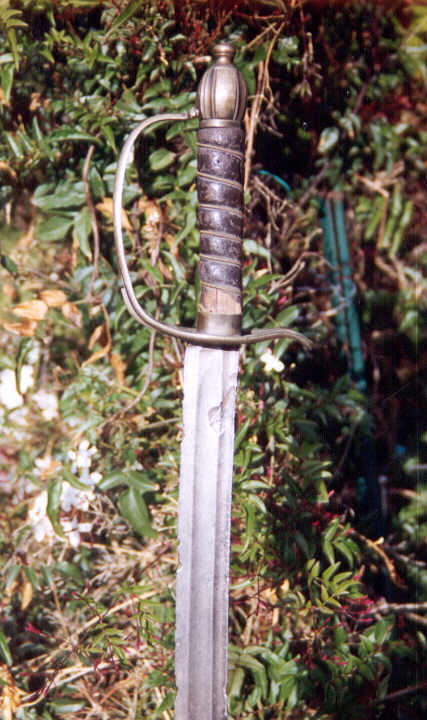
|
|
   |
 |
Eric S

|
 Posted: Fri 22 Sep, 2017 6:44 am Post subject: Posted: Fri 22 Sep, 2017 6:44 am Post subject: |
 |
|
Here is an example of a European blade on an Indian hilt. "Firangi" an Indian word meaning ‘foreigner or foreign’ is used to describe Indian swords which used blades manufactured in Western Europe and imported into India, initially by the Portuguese and later by other European countries, or made locally in imitation of European blades. 18-19 century. Blade 37 inches, total length 48 inches, khanda type hilt.

https://www.pinterest.com/worldantiques/
|
|
   |
 |
Eric S

|
 Posted: Fri 22 Sep, 2017 10:36 am Post subject: Posted: Fri 22 Sep, 2017 10:36 am Post subject: |
 |
|
The Ottoman Empire stretched from the middle east to Europe, various cultures aligned with the Ottomans adopted the yatagan / yataghan as their weapon of choice. While identifiable as yatagan, the blade, scabbards and hilts often identified were the owner of a particular yatagan came from. As a fairly long lived weapon, yatagan blade shapes changed over time.
Here is an interesting Ottoman "zeybek / zeibek" yatagan sword with typical T shaped hilt, pattern welded (damascus) blade known as "Turkish Ribbon", were bands of twisted steel ingots are forge welded between a high carbon steel edge and spine, extremely long (34 inch / 86.6cm cutting edge), 40 inch / 101.6cm total length. This is a full length sword, not a short sword as with most yatagan/yataghan. This is the longest yatagan I have come across so far.
The T handle yatagan is often seen in period photographs being worn by zeibek mountain people, of un-determined origin, the zeibek had a fearsome reputation as bandits, thieves, murderers, and they were used by the Ottoman government at various times as mercenaries and auxiliary troops during conflicts.

Yatagan of various size, shapes, hilts, and scabbards, from 34" cutting edge to 20" cutting edge.

Various sword types compared. #1 Ottoman yatagan, #2 Indian firangi, #3 Arabian / Saudi saif, #4 Indian hooded katar, #5 Indian tulwar hilted straight sword, #6 Ottoman shashka, #7 Japanese tachi, #8 Persian quadara, #9 Persia quadara, #10 Ottoman yatagan #11 Afghan khyber knife.

Zeibeks with their leather weapons belts (selahlik / silahlik) full of useful items, pistols, ramrods, daggers, swords. Note the extremely long, T handled yatagan swords both men carry. Les costumes populaires de la Turquie en 1873.

https://www.pinterest.com/worldantiques/
|
|
   |
 |
|
E.B. Erickson
Industry Professional
|
 Posted: Tue 26 Sep, 2017 4:12 am Post subject: Posted: Tue 26 Sep, 2017 4:12 am Post subject: |
 |
|
Here's an interesting sword: English, 1630-40. 31” SE blade with one narrow back fuller, with an inlaid copper bladesmith's mark. Hilt of shell shape to the right, a trilobate shell (damaged) on the left. Main knucklebow with central shell, attached to pommel by a screw. Scrolled quillon. Side knucklebow similar to that seen on later Mortuary hilts, also secured to the pommel by a a screw. Large faceted pommel. Original wooden grip.
Condition: Dark, stabilized oxidation overall. The sword appears to never have been apart. When purchased, the hilt was deformed, but I managed to carefully bend things so that it is now close in form to what it originally was. The screw attaching the main knucklebow was partially stripped due to the hilt deformation, but since it is frozen in position, it was left alone. One of the scrolled ends to the side knucklebow is a modern brazed on not-too-well-done restoration, and one day I plan to redo this restoration to better match the original.
The trilobate shell on the left has been broken, and while I had originally intended to restore the missing portions, I have decided to leave it alone.
The scrolled front quillon has suffered some delamination.
The grip is octagonal in section, cracked and wormed. There is a partially-collapsed section due to subsurface worm damage. Since the grip is original, I opted for conservation, and stabilized it with CA glue.
The blade isn't too worn, and appears to be of original length, although it has been resharpened multiple times. Besides the copper cross, the left side of the blade bears remains of circular stamps and engraved lines, but these were too faint to photograph well.
So how does one classify this hilt? Although the knucklebow's central shell and the form of the side guard are found on Mortuary and Proto-Mortuary hilts, this hilt is structurally different from both (although you could make a case for this being a type of Proto-Mort). Discussion, anyone?
 Attachment: 86.79 KB Attachment: 86.79 KB
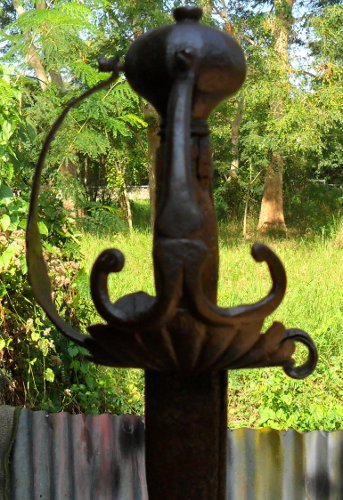
 Attachment: 91.66 KB Attachment: 91.66 KB
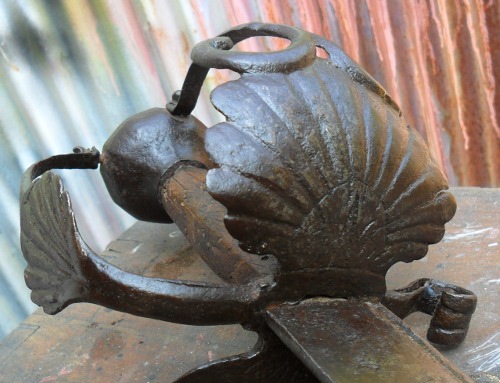
 Attachment: 93.14 KB Attachment: 93.14 KB
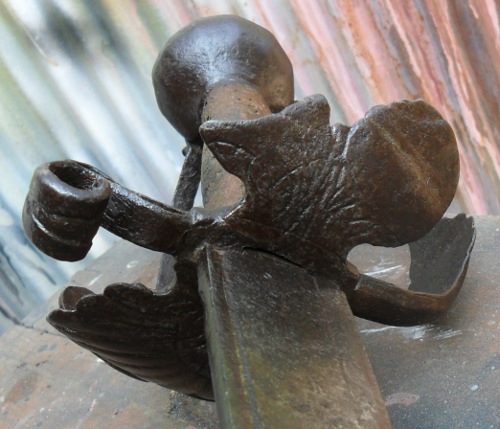
 Attachment: 89.1 KB Attachment: 89.1 KB
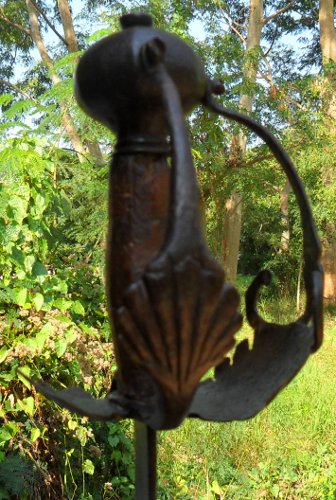
 Attachment: 97.31 KB Attachment: 97.31 KB
[ Download ]
|
|
   |
 |
Roger Hooper

|
 Posted: Wed 27 Sep, 2017 2:43 pm Post subject: Posted: Wed 27 Sep, 2017 2:43 pm Post subject: |
 |
|
About ElJay's sword -
Perhaps one could make a case for its being a variation on a Hounslow hanger, but I vote for its being classified as a Proto-Mort. There was a lot of variation between Mortuary swords. This one is certainly unlike many of them, but it has many individual features that appear on other Morts.
|
|
  |
 |
Eric S

|
 Posted: Thu 28 Sep, 2017 11:28 pm Post subject: Posted: Thu 28 Sep, 2017 11:28 pm Post subject: |
 |
|
I bought this Persian percussion smooth bore, long gun at auction, it was wrongly described as being Caucasian and the stock had a noticeable crack or splice separation. Persian guns are rather rare, in my opinion possibly due to the Persians early adoption of European firearms and this gun seems to be a very late model, possibly from the last phase of traditional Persian guns. Percussion guns came into service around the 1840 so this gun would be from around that time period or later,
I asked around in order to find someone who could repair the stock and I decided to contact Philip Tom as his repair / restoration work was highly recommended to me. Philip did a fantastic job, and fortunately the stock was just separated at a joint were two pieces had been spliced together. I am really happy with the results, I have no plans to fire it and wanted as little work done on it as possible.
In Philip's words before repair....."there is one oblique crack crossing the point where the sling slot is. Disassembly will be needed to see if there are any related problems inside, and also need to see if I have to address any losses along the edge. I would need the whole gun to work on since the barrel has to be kept in place for proper alignment. The lock is a civilian version, possibly Eastern-made, of a mid-19th cent. Enfield percussion regulation pattern. The main difference being stylistic, a flat surfaced hammer, and a slightly different profile just on the front end of the plate."
After repair.
"As you can see from the differences in grain, this wasn't so much a stress break, but a separation of a diagonal joint in a two-piece stock. When scraping off the crud, there were traces of the original organic glue under the newer clear adhesive of the later amateur repair. The saw cuts on the mating surface weren't perfectly smooth so I had to dig the old stuff out of the crevices to make sure my repair had 100% contact.
The inlaid bone sling escutcheons have these pieces of brass inlaid in them, these are not original and were probably put in by the guy who did the last repair. Rawhide thongs once went through these, which were knotted through holes at the end of the wider leather belt that served as a sling. I decided to leave the brass in, even though not original, because taking them out might open another can of worms as far as stability of the inlays. If it can be done cheaply, a local gunsmith can install a bead type brass shotgun sight in the hole in the barrel. That's what it had originally since the barrel is off an English sporting gun.
Mechanical repair to the firing mechanism isn't any priority since you're not planning to shoot this. The percussion nipple is all munged up and needs to be drilled out and replaced with a new one -- too much money and the new nipple is going to stick out like a sore thumb. The gun looks great as is in an ethnographic collection. As you probably know, the style of stock inlay and the overall quality mark it as being a provincial piece, from one of the tribal areas, probably from southeast Iran since the decor is reminiscent of the circular motifs on the grips of chooras and other daggers from Afghanistan and the Sind."
Before repair.

Lock, barrel, and stock taken apart for repair.

After repair.

https://www.pinterest.com/worldantiques/
|
|
   |
 |
|
E.B. Erickson
Industry Professional
|
 Posted: Mon 02 Oct, 2017 5:43 am Post subject: Posted: Mon 02 Oct, 2017 5:43 am Post subject: |
 |
|
Time for a couple of odd swords!
Description: 1788 Light Cavalry sword with unusual guard
Blade: normal 1788 type, 36" long; spine signed "Wooley"
Grip/backstrap: normal 1788 type. The sharkskin retains impressions of the langets of a normal 1788 guard.
Guard: steel, with two side branches on the right, and half of a four-slot design on the left.
Comments: When I spotted this sword at a gunshow in 1991, I immediately thought it was a composite, due to the langet impressions in the grip. The backstrap had become sprung from it's hole in the guard, and try as I might, there was too much grip warping to merely push the stud back in the hole. So I disassembled the sword, and discovered that the tang hadn't been disturbed for a looong time. So was this guard possibly a period modification? The entire sword was covered with dark grime, but not much rust. I began gently cleaning, and discovered traces of japanning to the backstrap. The guard itself had lots of japanning in spots, and the underside where the blade seats retains virtually all of it's original japanning. Between the tang condition and the japanning (both old arsenals and army units used japanning for preservation), I came to the conclusion that this sword was either an experiment, or a unit modification. If it's a unit's mod, there may be others out there--has anyone seen another 1788 like this?
 Attachment: 32.37 KB Attachment: 32.37 KB
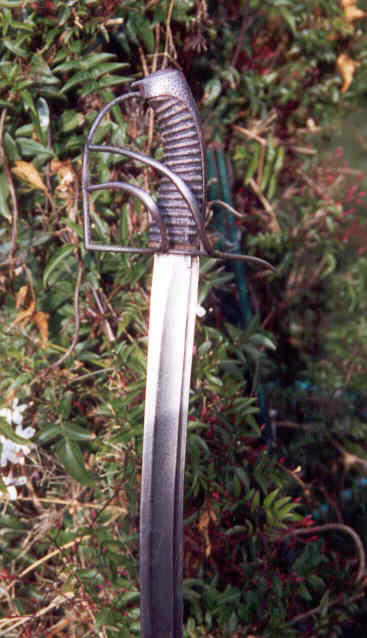
 Attachment: 17.33 KB Attachment: 17.33 KB
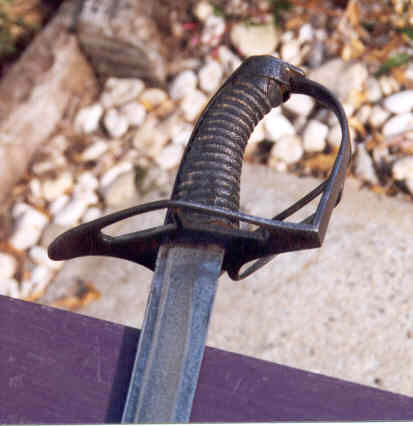
|
|
   |
 |
|
E.B. Erickson
Industry Professional
|
 Posted: Mon 02 Oct, 2017 5:47 am Post subject: Posted: Mon 02 Oct, 2017 5:47 am Post subject: |
 |
|
Another unusual sword.
1796 Light Cavalry Officer's Sword with folding sideguard.
Blade is normal 1796 dimensions, and retains considerable bluing and gilding. Blade is signed "Osborn's Warranted".
Scabbard has lost most of the gilding on it's mounts. Top chape is detached and has had the hanging ring broken off; is signed "Henry Osborn, Bordesly near Birmingham"
Hilt is of gilt copper, pretty worn. The quillon is a restoration (and a little too straight). Original leather covered grip with wire wrap.
The interesting feature is the hinged sideguard, ala the French "attack" guards. The facetted ferrule at the grip base has a knob protruding on the right side. The knob is connected to a blade that engages a slot on the hinged sideguard to lock it in place when extended. The spring inside the ferrule that activated the knob/blade is either broken or jammed, and the blade no longer engages the slot, so you can't lock the sideguard now.
 Attachment: 28.24 KB Attachment: 28.24 KB
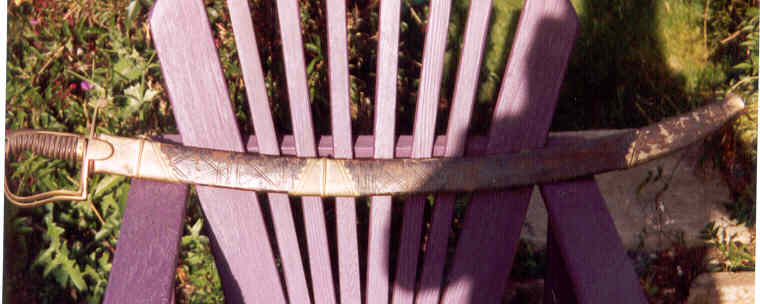
 Attachment: 28.71 KB Attachment: 28.71 KB
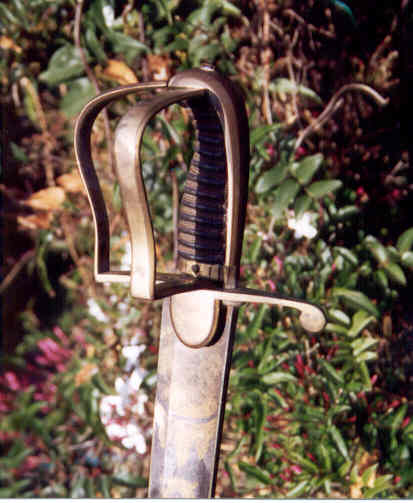
|
|
   |
 |
Daniel Parry

|
 Posted: Sat 14 Oct, 2017 1:34 pm Post subject: Posted: Sat 14 Oct, 2017 1:34 pm Post subject: |
 |
|
I have not posted on this site for many years as I mostly collect antiques but I keep an eye on it for discussions of antique swords and I also like Bill Grandy's reviews of modern reproductions of original rapiers and their handling characteristics as I find them very informative being a poor historical fencer myself.
Anyway, I thought I would post some items from my collection that I thought were interesting for one reason or another. Most of them are recent acquisitions of the last few years as the older ones are either high enough on the wall that I'd need the step ladder to get them down or are in the attic storage. I also apologise for my poor photographic skills and the horrible beige carpet on my study floor which is the background. I need a new carpet.
First one is a German ring hilted arming sword, first half of the 16th century. This a nice sword. The decoration is simple but very nicely executed. The sword is beautifully balanced and although a large sword which can take a hand and a half grip, it is feels very light and quick, Blade is triple fullered, and a cutting blade as well as a thrusting one. Its has triple Solingen wolf marks on either side of the forte with crowns on top. The blade is 411/2 inches long and the weight is 1.494kg. It is a lovely sword and although simple, everything about it speaks of quality. I like it. I hope I worked out how to add the photos correctly.
[/img]
|
|
  |
 |
Daniel Parry

|
 Posted: Sat 14 Oct, 2017 1:55 pm Post subject: Posted: Sat 14 Oct, 2017 1:55 pm Post subject: |
 |
|
I clearly didn't understand how to do the photos ! Trying again. Still struggling.
 Attachment: 3.46 KB Attachment: 3.46 KB
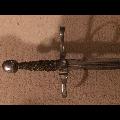
|
|
  |
 |
Daniel Parry

|
 Posted: Sat 14 Oct, 2017 2:09 pm Post subject: Posted: Sat 14 Oct, 2017 2:09 pm Post subject: |
 |
|
This an English rapier from probably 1620 - 1640. It is probably closest to a Norman type 86 or 73 hilt. This is a beautifully balanced rapier that just floats in the hand when held. Like many rapiers it has lost its hilt surface colour and is in the white. The hilt has a silver wire grip and the overall quality and feel of the sword is really great. It has a diamond cross section, stiff and very narrow blade. The length of the blade is 37.5 inches from the guard. The weight is 945grammes.
 Attachment: 3.68 KB Attachment: 3.68 KB
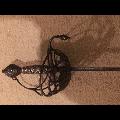
 Attachment: 2.71 KB Attachment: 2.71 KB
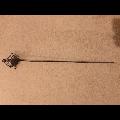
|
|
  |
 |
Daniel Parry

|
 Posted: Sat 14 Oct, 2017 2:25 pm Post subject: Posted: Sat 14 Oct, 2017 2:25 pm Post subject: |
 |
|
This an interesting English rapier I think. It is one of the group of rapiers often described as duelling rapiers from the early to mid 17th century and often from northern European countries and more often from England. They are interesting because in their purest form, when compared to more ornate, decorative and often heavier 'normal' rapiers of the period they are like stripped down racing cars. There is nothing in their construction which is not functional. Nothing which adds unnecessary weight or bulk, no decoration, They are sleek and deadly and although the few I have owned or handles have no maker's marks they are generally of very high quality construction. The steel of the blade on this rapier is the most flexible I have ever encountered. I know from experience having tripped over one of my son's toys on the landing while carrying downstairs - the point dug into the carpet and the blade bent to an alarming degree but there was no snap. It sprang back into perfect shape. The blade is both a thrusting and cutting blade of flat diamond section and clearly had an edge for the last half of the blade.
This group of rapiers is the lightest of all the rapiers I have encountered and this one weighs in at 699grammes with a blade of 361/2 inches from the guard. Very light and agile.
 Attachment: 2.66 KB Attachment: 2.66 KB
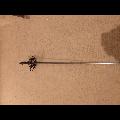
 Attachment: 3.56 KB Attachment: 3.56 KB
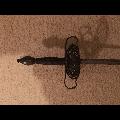
|
|
  |
 |
Daniel Parry

|
 Posted: Sat 14 Oct, 2017 2:39 pm Post subject: Posted: Sat 14 Oct, 2017 2:39 pm Post subject: |
 |
|
This is a big rapier. Probably Italian and I think 1620-1630 judging by the overall feel, dimensions, pommel and hilt decoration but it could be later. The blade is 451/2 inches from the guard, 481/2 inches including the ricasso. The blade is a solid flat hexagonal cross section turning into flat diamond after the forte. The blade is quite wide compared to some of the increasingly needle like blades of the period and could take an edge. The sword is a little blade heavy, not surprising given the length of the blade, and is heavy for a 17th century rapier at 1.477grammes. But it is well balanced, as are most good historical swords, as they were practical tools, and it is not nearly as cumbersome as you would think when you first see it (it is massive!). In terms of dimensions and balance it would not be my instinctive choice to fence with but the length of the blade does mean you get a reach advantage and potentially the ability to keep your opponent at bay. Ricasso has a crown and CS mark. Forte has a cross on top of a globe on each side.
 Attachment: 3.67 KB Attachment: 3.67 KB
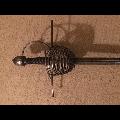
 Attachment: 2.54 KB Attachment: 2.54 KB
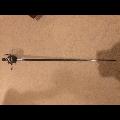
|
|
  |
 |
Daniel Parry

|
 Posted: Sat 14 Oct, 2017 2:53 pm Post subject: Posted: Sat 14 Oct, 2017 2:53 pm Post subject: |
 |
|
This is another long one. Spanish cup hilt rapier c1650-1670. Long blade 45 3/4 inches from the guard, 47 3/4 including the ricasso. Slightly blade heavy. Although the grip and quillons and pommel are perfectly in keeping with the style and dimensions of the period for a Spanish rapier I have my suspicions about them. Firstly the disparity in decoration between the very finely chiselled cup and fine quality blade and the workman-like grip and pommel don't quite match, Secondly I find one of the best judges of a good quality original sword is the balance. Good quality swords did not have bad balance. I am not saying that a rapier should have the balance of a modern fencing epee but this one is just slightly off and I thing it had a different and slightly heavier grip and pommel originally. Very nice classic Spanish cup hilt over all though. Weight is 1038 grammes.
 Attachment: 3.94 KB Attachment: 3.94 KB
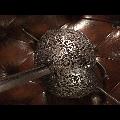
 Attachment: 2.47 KB Attachment: 2.47 KB
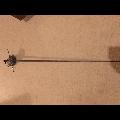
 Attachment: 3.42 KB Attachment: 3.42 KB
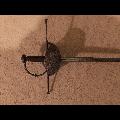
|
|
  |
 |
Daniel Parry

|
 Posted: Sat 14 Oct, 2017 3:13 pm Post subject: Posted: Sat 14 Oct, 2017 3:13 pm Post subject: |
 |
|
I like this rapier for two reasons. Firstly it's a boat hilt which you don't come across that often, and secondly because of it's understated effectiveness. It is probably Spanish, 1650-1670. The pommel is a bit suspicious. You don't get many wheel pommels on rapiers and if anything the period and the patina of the pommel suggests it might be older than the rest of the sword. This sword has no decoration. It has a very good hand-protecting cup pierced with small holes. It is a plane Jane rapier that would not attract immediate attention at an auction or a fair. Its when you pick it up that you realise it's an absolute beast. It weighs 837 grammes, so very light. The blade is a falrly rigid diamond section narrow blade but it flares into a slight spatula strammazone shape in the last 7 inches to allow cutting strokes. It is so quick but is also has a weight to it that could help control another blade. Balance pretty much perfect. Of all the rapiers I have owned or handled, if I were to face the unfortunate situation of having to fight a duel for my life at dawn, this is the one I would take. It is functionally brilliant. No decoration but I think made by a man who knew exactly what he was doing for a customer who knew exactly what he was doing. The cup shows impact piercings which under a magnifying glass are the exact shape of the point of a rapier of that period so I suspect it had real use.
 Attachment: 2.16 KB Attachment: 2.16 KB
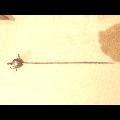
 Attachment: 1.99 KB Attachment: 1.99 KB
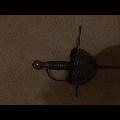
 Attachment: 2.97 KB Attachment: 2.97 KB
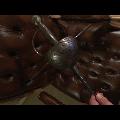
|
|
  |
 |
|
|
You cannot post new topics in this forum
You cannot reply to topics in this forum
You cannot edit your posts in this forum
You cannot delete your posts in this forum
You cannot vote in polls in this forum
You cannot attach files in this forum
You can download files in this forum
|
All contents © Copyright 2003-2024 myArmoury.com — All rights reserved
Discussion forums powered by phpBB © The phpBB Group
Switch to the Basic Low-bandwidth Version of the forum
|

